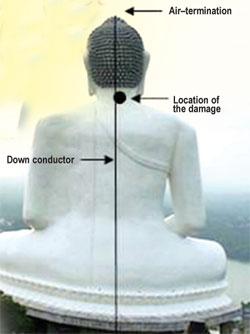Prof. Chandima Gomes / Head, Centre for Electromagnetic and Lightning Protection Research / Universiti Putra Malaysia
Source - http://www.island.lk/index.php?page_cat=article-details&page=article-details&code_title=64544

Lightning damage to Pratapur Buddhist Temple in Kathmandu, Nepal. Lightning leapt out damaging the structure at the base level. Left hand side picture shows the twin of the damaged monument which is identical in appearance to the damaged one.
It was reported on Oct. 23 that a portion of wall near the Lion’s Paw of the Sigiriya Fortress had collapsed due to a lightning flash around 2.30 pm. Two days later the Director General of the Archaeology Department, said that the damage was due to the dilapidated condition of the wall and not due to lightning. He also said that lightning protection devices had been installed in many archaeological sites.
The question is how the Archaeological Department concluded that the damage to the Sigiriya wall suffered was not due to lightning within less than 24 hours. Usually such investigation takes at least 2-3 days of site inspection by a lightning forensic expert team plus another week of data analysises before drawing a conclusion.
I have carefully gone through photographs related to this incident available in the media so far. Although there is the possibility of the wall collapsing due to other factors experienced with several such ancient structures struck by lightning, compels me to believe that the chance of this being due to lightning is quite high.
When a structure on rock is struck by lightning at the top, the current flows internally until it meets the high resistive rock. At that point it may leap out causing the masonry to collapse and spread around as surface discharges.

The picture shows damage caused by to Pratapur Buddhist Temple in Kathmandu, Nepal. This is also an on-rock temple which is highly prone to lightning due to its topography. One can clearly see that lightning current has emerged out of the structure damaging the masonry close to the base of the structure. In this case the top of the building was ripped off, however, I have come across cases where there are hardly any evidence of damage at the point of strike.
The second question is the design of lightning protection system installed at other sites as claimed by the archaeological department. It should be emphasized that a lightning structural protection system for a monument with high cultural value is not simply one or few air-termination, copper tape and grounding rod. Once the lightning is attached to the air termination, it should be taken to ground level by a system of metal conductors. During this current passage a large voltage travels along these conductors which can result an ultra hot fire arc from lightning protection system (LPS) to nearby metal parts. For avoiding such sparking nearby metal structures should be either bonded to the LPS or separated by a certain calculated minimum distance. Sparking not only trigger fires, they generate shock waves that may cause micro cracks even in rock.

Damage caused by lightning to the Buddha statue on Athagala. Note that the down conductor has been marked with a black line.
Picture above shows a mishap few years ago at the sacred Buddha Statue on Athagala, Kurunegala. Irrespective of the lightning protection system (which was wrongly designed), lightning that hit the protection system at the top, entered the steel reinforcement of the sacred structure at neck level, damaging the masonry. There may also be unnoticed elementary cracks in the base level of the statue where the lightning current has re-emerged to the surface.
At ground level various protection measures such as euipotential bonding, isolation, distributed earthing design etc should be adopted to minimize surface arcing and human hazards. All power codes in the vicinity should be protected by surge protection devices.
When lightning current flows inside an unprotected structure such as walls of an ancient monument, or leaps as surface acing, many filamentary mechanical cracks may be created. These cracks will take many decades or even a century to cause a catastrophic damage. Hence for ordinary structures, these micro damage may not cause any significant impact. However for a structure that needs to be preserved for many generations to come, we need to take all possible precautions to prevent such mishaps.
Now we come back to the first question. If the Archaeological Department’s claim is wrong and the structure is actually struck by lightning, it may be too dangerous to leave it in the hands of nature to decide its future. If another part of the structure collapses in 50 years in broad daylight (due to micro cracks caused by recent lightning strike), everyone will credit the damage to natural degradation and absolve themselves of the responsibility for failure to protect the monument. Therefore, I insist that a proper forensic study be conducted and the real cause of damage ascertained.
As regards the second question, it is the responsibility of the archaeological authorities to ensure that lightning protection systems at archaeological sites are properly designed and correctly installed.